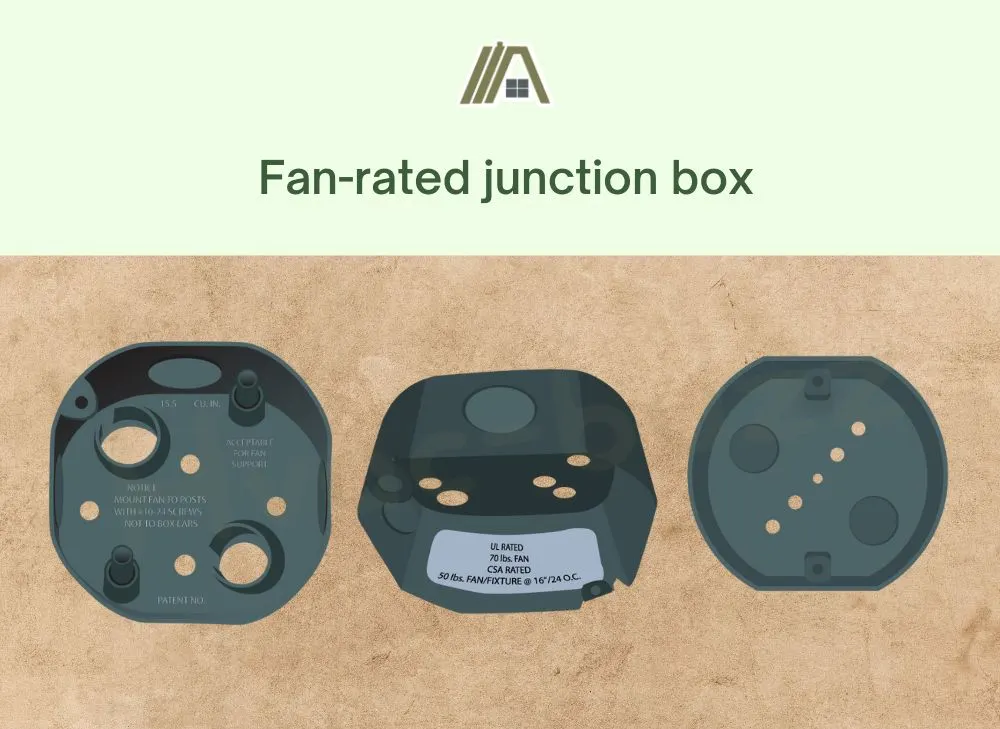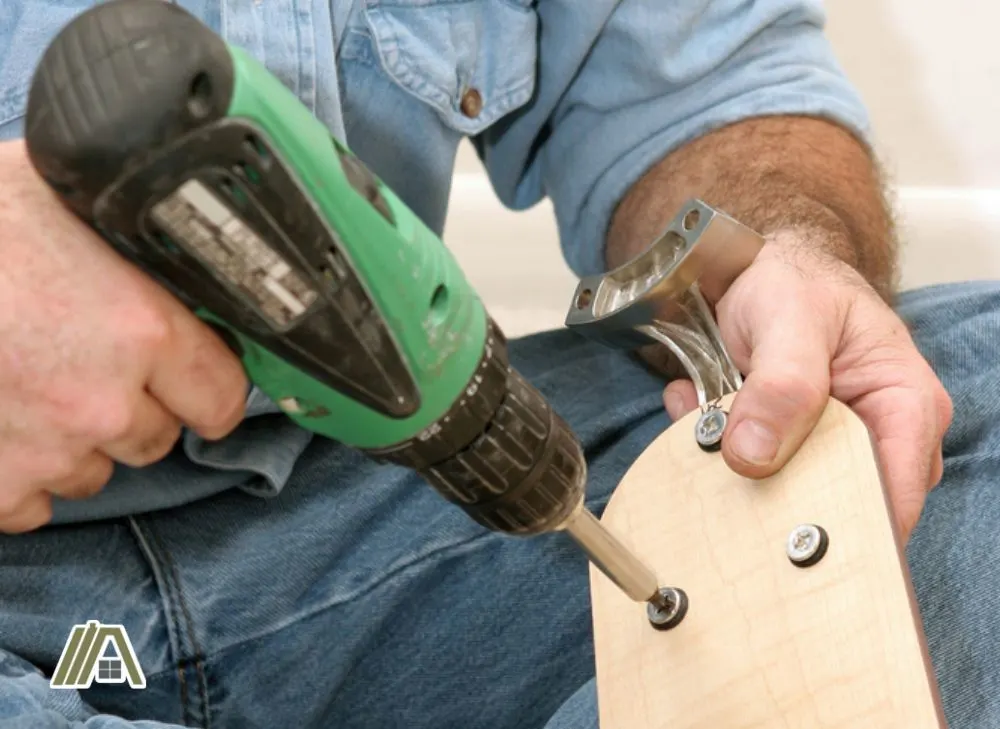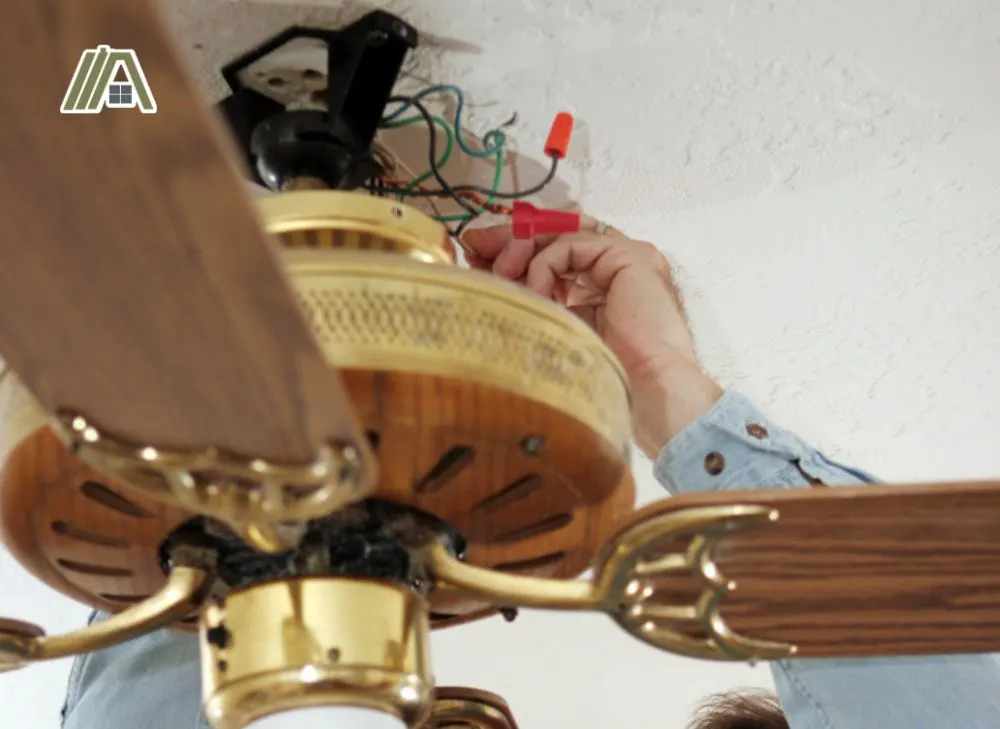The only sound you should be hearing from your fan is a whirring noise (more associated with higher speed), which is caused by the blades moving through the air, and possibly an unobtrusive but distinctive motor noise (less likely with DC fans). If your ceiling fan has developed a hum, then it’s time to investigate. The cause is either going to be vibrations or faulty electrics.

- Loose screws
- Incorrect junction box
- Skewed installed
- Dry bearings
- Debris in canopy/motor housing
- Loose blades
- Unbalanced blades
- Loose wiring
- Faulty wiring
- Power surges
- Dimmer switches
- Incorrect bulb wattage
- Faulty remote control receiver
1. Loose Screws
Loose screws vibrate in the fan to cause a humming sound. Paradoxically, fan vibrations are also what can cause screws to loosen over time.
To see if this is the issue, you can just pull out your ladder, climb up and start jiggling parts of the fan. Do they move when they are not supposed to? Sometimes, you can visibly see that a screw has come loose.
Now, there are a good many screws in a ceiling fan, so you’ll have a lot of places to check, starting at the junction box and ending with the light sockets and fan blades.
The solution to loose screws is, obviously, to tighten them. If you don’t find any that are obviously loose, I would suggest that you still try to tighten them all anyway—it won’t cause any harm and it will make sure that you aren’t back up the ladder in a week or two because the screws have come loose.
Make sure that the screws you tighten do actually tighten. If the screws are stripped, then it will just work loose again very shortly. In these cases, you can try to replace the screw.
2. Incorrect Junction Box Used
For ceiling fans over 35 lbs, you have to use a special ceiling fan junction box, which is rated to support a greater weight. If you used the existing junction box and it is only rated for light fixture usage, then your problem could be a wobbling fan.

When fans wobble, parts that are not supposed to touch, do touch. And parts that are not supposed to move, can move. If these touches or movements occur rapidly enough or are sustained enough, then you get a humming noise.
Ceiling fan wobbles can usually be identified visually. However, there are multiple causes (we’ll get to some more of them later), which makes identifying the cause a bit trickier.
Happily, it should be relatively easy to check if you have the correct junction box. Just climb up the ladder, take off the canopy and look at the junction box. It should say what it is rated for. Then check the weight of your fan by looking on the box, online, or in the owner manual.
If they are compatible, then this is probably not the cause (even if the fan’s wobbling!) and you can move on in your troubleshooting quest.
Should you find that the junction box and fan are incompatible, you will have to replace the box. This is not only required to stop the wobbling and humming, but also to make your ceiling fan installation compliant with the electrical code.
3. Skewed Installation
When your ceiling fan is not installed level with the ceiling, then the canopy, which covers the junction box, wiring, and the hole in the ceiling, can vibrate against the ceiling boards, creating a humming sound. It can also cause the whole fan to wobble.
You should be able to see if the fan is skew, particularly if you climb up and examine the the canopy. Is it sitting flush, or can you press it closer to the ceiling?
You can also measure the distance between the blades and the ceiling. The only issue with this technique is that unbalanced blades can also produce uneven measurements.
If you find that this is your problem, then you will have to straighten the ceiling fan.
Depending on how skew it is or what part of the installation when off, this could be a matter of unscrewing some screws, wiggling a part, and screwing it back in. Or it could involve unwiring the fan and taking it down to start installation afresh.
You may even require the assistance of an electrician in some cases.
4. Bearings Require Lubrication
All ceiling fans have ball bearings. These help to make the rotation of the blades smooth. To help them facilitate this, they have to be lubricated.
If they are not lubricated, then there is an increase in the amount of friction and it can cause a hum to develop as metal parts grate over each other rapidly. This can also be accompanied by a grinding sound.
Another possible cause of humming as a result of dry ball bearings is that the motor has to work harder to rotate the blades. As the motor strains, it can start to hum or whine.
In newer models, the ball bearings are self-lubricating, but in older models, you have to oil them as part of routine ceiling fan maintenance.
Check to see if your fan has a small hole on the fan assembly. It may be labeled “oil”, or you may be able to confirm that this is what it is by looking in your manual. If you do find that there is an oil hole but you have never lubricated it, then buy some oil, top up the fan, and see if the humming goes away.
If you cannot location an oil hole, then it is still possible that the ball bearing need lubrication. In this case, however, your solution is going to be replacing the self-lubricating bearings. This is not the easiest task, so you want to make absolutely sure that this is the problem before you attempt to replace them (or have them replaced).
To lubricate the ball bearings, you will need to purchase a ceiling fan lubricant online or from a hardware store. Once you have the lubricant, turn off the fan and apply the lubricant to the ball bearings by inserting a small amount into the hole in the ceiling fan’s motor.
5. Debris in the Canopy/Motor Housing
If you have debris in the canopy or motor housing, then as your fan spins and produces vibrations, these small pieces can start bouncing around in the canopy or motor housing.
Depending on the nature of the debris, this can manifest as a humming sound. Or it might be more of a rattle on lower speeds but sound like a hum on higher speeds as the debris is bounced more rapidly.
To fix this, you will need to remove the canopy or open up the motor housing and clean it out using a cloth or a handheld vacuum. Be sure to turn off the power to the fan before you begin!
Once you have cleaned the canopy and motor housing, be sure to put everything back in place and restore the power to the fan.
6. Blades Are Loose
Loose blades are another possible cause of humming for three reasons:
- It probably means that you have some loose screws which can vibrate in their holes.
- The blade can vibrate in the bracket.
- The loose blades unbalance the fan and cause it to wobble.
Wiggle the blades of the fan in their brackets and see what happens. If they move, then it’s time to pull out the screwdriver and tighten them up.

7. Unbalanced Blades
Unbalanced blades are another cause of wobbling in ceiling fans, and, thus, humming. But what causes blades to be unbalanced?
Over time, ceiling fan blades can become bent, warped, or dirty. Cleaning them, hanging things from them, replacing them, etc., lead to them being unbalanced.
You should be able to measure the distance between the blades and the ceiling to see if the blades are off balance. Measure on the same point of each blade and to the same point on the ceiling (rotate the fan).
To fix this issue, you will need to balance the ceiling fan blades. First, turn off the power to the ceiling fan at the circuit breaker. Next, use a ladder and a screwdriver to carefully remove the ceiling fan blades one at a time.
Once all of the blades have been removed, check each one for signs of damage. If you find any dirty or damaged blades, clean them, use a balancing kit (amazon link), or replace them with new ones. Then, reattach the ceiling fan blades.
8. Loose Wiring
Remember how I said that humming can indicate an electrical issue? Well, loose wiring is one of these issues.
If wiring is loose, then the connections are going to be fractured. Motors don’t like fractured electrical connections and can start to make noises. The hum can even be coming from the connection point itself as the current buzzes between contact and no contact.
In addition to the humming, you might notice flickering ceiling fan lights, inconsistent speed, and even smoking or burning smells.
Tightening a loose connection is pretty easy. You just have to wrap the wires around the screws properly and tighten the screws, or you just need to refit the connection screw-caps.
The following are places where wires can come loose:
- Fan motor
- Light sockets
- Receiver
Simply turn off the breaker, pull off the canopy and tighten the wire connections.
9. Faulty wiring
If you’ve checked inside the motor housing of your ceiling fan, you may have discovered that the wires are not loose. Instead, the wires are damaged or installed incorrectly. This can happen during installation or over time as the ceiling fan ages.

Signs of faulty wiring include flickering lights, sparks, or a burning smell. Faulty wiring can also create a humming noise because the ceiling fan is not receiving the correct amount of power. If you notice any of these signs, immediately turn off the power to the ceiling fan at the circuit breaker.
After you have turned off the power to the fan, consult an electrician. Do not try to fix the problem yourself, as you could cause further damage or even start a fire. An experienced electrician will be able to fix the wires and get your fan up and running again.
10. Power Surges
Your ceiling fan may be humming because it was affected by a recent power surge. A power surge occurs when the voltage supplied to an appliance or device is suddenly increased. This can happen for a number of reasons, but usually a surge originates from the electric utility company.
Power surges can damage your ceiling fan motor or wiring, causing humming among other more or less serious issues.
If you think that a power surge may have caused damage to your ceiling fan, you should contact an electrician. They will be able to inspect the ceiling fan and fix it, or determine if it needs to be replaced.
11. Dimmer Switches
Dimmer switches are not compatible with ceiling fans and can cause them to malfunction. With a dimmer switch, the amount of power being supplied to the fan is sometimes sufficient, and sometimes not. This can cause an electrical humming in the same way as loose wiring, but it is potentially more damaging to the motor.
A dimmer switch may cause humming, but it can also cause ceiling fan motors to overheat and burn out. In the worst case scenario, your overheated ceiling fan may start a fire.
If you don’t have ceiling fan lights, then change to a standard switch.
If you have ceiling fan lights, then make sure that the lights and ceiling fan are wired separately. You can do this quite easily as ceiling fans usually have separate live wires for the fan motor and the lights (the lights will be attached to the red wire). You then just separate them at the switch.
12. Bulbs of Incorrect Wattage
Your ceiling fan could be humming because you’re using incorrect wattage lightbulbs. If you’re using bulbs that have the incorrect wattage, your ceiling fan is likely overheated. An overheated ceiling fan often develops a humming noise.
If you have recently changed bulbs, then this could be the issue. If you have not and your fan has started humming all of a sudden, then it is unlikely to be the result of incorrect bulbs.
To fix this problem, simply replace the lightbulbs with bulbs of the correct wattage. You can find information on the correct wattage for your ceiling fan in the owner’s manual or on the manufacturer’s website. Remember that LEDs and incandescent bulbs use different wattage measurements.
Once you have replaced the lightbulbs, turn on the ceiling fan to make sure that the humming noise has stopped.
13. Remote Control Receiver is Faulty
The humming noise that you’re hearing could be caused by the ceiling fan’s remote receiver. If you observe any of the following signs, the ceiling fan remote receiver may be malfunctioning:
- the ceiling fan is not working properly
- the ceiling fan blades are moving erratically
- the ceiling fan making strange noises, such as humming
With remote-controlled ceiling fans, the receiver is responsible for feeding the correct amount of power to the correct part of the fan when you press a button on the remote. If the receiver is faulty, the electrical circuit of the fan can be disrupted, and this can cause an electrical hum.
It may be time to replace the ceiling fan remote receiver. You can purchase a new universal ceiling fan receiver and remote (amazon link) online and at most hardware stores. Once you have the new receiver, follow the instructions that come with it to install it.
Alternatively, check with the fan’s manufacturer. If your fan is under warranty, they may replace it free of charge.
Sources
https://handymanoflasvegas.com/wobbly-ceiling-fan-caused-by-loose-box/
https://www.ehow.com/how_7890886_fix-loose-electrical-ceiling-box.html
https://www.coynecollege.edu/warning-signs-of-faulty-electrical-wiring/
https://www.statefarm.com/simple-insights/residence/are-power-surges-damaging-your-electronics



